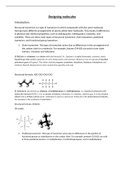Designing molecules
Introduction:
Structural isomerism is a type of isomerism in which compounds with the same molecular
formula have different arrangements of atoms within their molecules. This results in differences
in physical and chemical properties, such as boiling point, melting point, reactivity, and
solubility. There are three main types of structural isomerism: chain isomerism, positional
isomerism, and functional group isomerism.
1. Chain isomerism: This type of isomerism arises due to differences in the arrangement of
the carbon chain in a molecule. For example, butane (C4H10) can exist in two chain
isomers: n-butane and isobutane.
a) Butane or n-butane is an alkane with the formula C H . Butane is a highly flammable, colorless, easily
4 10
liquefied gas that quickly vaporizes at room temperature and pressure. Butane is one of a group of liquefied
petroleum gases (LP gases). The others include propane, propylene, butadiene, butylene, isobutylene and
mixtures thereof. Butane burns more cleanly than gasoline and coal.
Structural formula: H3C-CH2-CH2-CH3
b) Isobutane, also known as i-butane, 2-methylpropane or methylpropane, is a chemical compound with
molecular formula HC(CH3)3. It is an isomer of butane. Isobutane is a colorless, odorless gas. It is the simplest
alkane with a tertiary carbon atom. Isobutane is used as a precursor molecule in the petrochemical industry,
for example in the synthesis of isooctane.[6]
Structural formula: (H3C)3C-
3D model:
2. Positional isomerism: This type of isomerism arises due to differences in the position of
functional groups or substituents on the carbon chain. For example, pentane (C5H12) can exist
in three positional isomers: 2-methylbutane, 2,2-dimethylpropane, and 3-methylbutane.
, a) Isopentane, also called methyl butane or 2-methylbutane, is a branched-chain saturated hydrocarbon (an
alkane) with five carbon atoms, with formula C
5H12 or CH(CH3)2(C2H5).
Isopentane is an volatile and flammable liquid. It is one of three structural isomers with the molecular
formula C5H12, the others being pentane (n-pentane) and neopentane (dimethyl propane).
Isopentane is commonly used in conjunction with liquid nitrogen to achieve a liquid bath temperature of
−160 °C. Natural gas typically contains 1% or less isopentane,[3] but it is a significant component of natural
gasoline.
Structural formula: CH3CH(CH3)CH2CH3
3D model:
b) . Neopentane, also called 2,2-dimethylpropane, is a double-branched-chain alkane with five carbon
atoms. Neopentane is a flammable gas at room temperature and pressure which can condense into a highly
volatile liquid on a cold day, in an ice bath, or when compressed to a higher pressure.
Neopentane is the simplest alkane with a quaternary carbon and has achiral tetrahedral symmetry It is one of
the three structural isomers with the molecular formula C5H12 (pentanes), the other two being n-pentane and
isopentane. Out of these three, it is the only one to be a gas at standard conditions; the others are liquids.
Structural formula: (H3C)3C-
3D model:
c) 3-Methylpentane is a branched alkane with the molecular formula C6H14. It is a structural isomer of hexane
composed of a methyl group bonded to the third carbon atom in a pentane chain. It is of similar structure to
the isomeric 2-methylpentane, which has the methyl group located on the second carbon of the pentane
chain.
Structural formula: CH3CH2CH(CH3) CH3
3D model:




